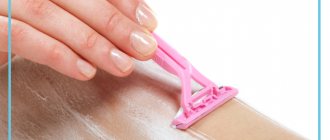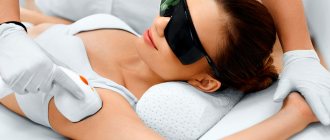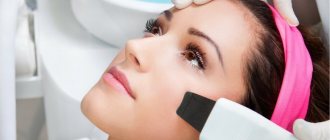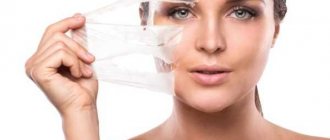From this article you will learn:
- How laser hair removal works
- 4 laser hair removal machines
- Preparing for the laser hair removal procedure
- 7 stages of laser hair removal
- Expected effect and skin care after laser hair removal
- Possible complications after laser hair removal
- Contraindications for laser hair removal
- Do-it-yourself laser hair removal
Care after laser hair removal is very important to obtain the desired effect. If basic rules are not followed, complications may arise in the form of allergic reactions and pain.
To get silky skin in appearance and touch, you need to understand what you can and cannot do after the procedure. In order to enjoy the result, and not eliminate negative consequences, it is important to take into account contraindications and follow the recommendations of a cosmetologist. This is exactly what our article is about.
How laser hair removal works
Laser hair removal is one of the most common and popular cosmetic procedures. The beauty industry produces a great variety of products designed to eliminate unwanted hair. However, after using some drugs and methods (for example, waxing or shaving), the effect does not last long. In addition, the skin often becomes irritated. After laser hair removal, hair disappears forever.
The procedure involves exposing the surface of the skin to light energy through a laser beam. Melanin found in hair follicles absorbs the laser during an hair removal session. The follicle heats up and stops functioning. In addition, there is a blockage of small capillaries that nourish the hair. In just a few sessions of laser skin treatment, you can get rid of growing hairs.
Due to a number of advantages, laser hair removal method is becoming increasingly popular. The advantages of this procedure include:
- high degree of efficiency;
- non-traumatic (even the bikini area will not be affected after laser hair removal);
- long lasting effect;
- no side effects;
- disappearance of ingrown hairs after the first laser hair removal session;
- almost painless removal of vegetation in the shin area (if the need arises, specialists treat the area with anesthetic cream or spray);
- The laser beam can deal with coarse and coarse hair.
The cost of the laser procedure is quite high. But despite this, women in most cases choose this method of hair removal. It allows you to get rid of unwanted vegetation in any area, even the most delicate and tender. According to experts, no allergic reactions occur after the laser hair removal procedure. Therefore, manipulation is not contraindicated for people with even the most sensitive skin.
It must be said that laser hair removal has one disadvantage. The greatest effect can be achieved if there is a contrast in the color of the epidermis and hair.
Red or light-colored hair is not sufficiently receptive to laser beams, unlike tanned and dark skin, which perfectly absorbs melanin from cells. Based on this, we can conclude that laser hair removal is most effective for those with fair skin and dark brown or black hair.
To achieve the ideal condition of your feet, you need to perform several procedures. The laser beam affects only growing hairs. If the bulb is dormant, nothing will affect it. Therefore, repeated sessions are necessary over several weeks. Dormant hair follicles will gradually be destroyed during subsequent treatments.
Numerous clients speak positively about this technique. Cosmetologists consider laser hair removal one of the safest procedures included in the arsenal of the modern beauty industry. The validity period of the result is increased thanks to a gentle method of treating the skin that does not harm it.
Late complications
If we consider the group of late complications of laser and photoepilation, we can distinguish hypo- and hyperpigmentation, scars, paradoxical hypertrichosis, leukotrichia, bromhidrosis, hyperhidrosis, malignancy or dysplasia of nevi in the area of the procedure.
1. Hypo- and hyperpigmentation are mainly a consequence of skin burns that occur during laser hair removal. They are most often found in tanned patients and people with skin phototypes III-VI. It has been noted that hypopigmentation often occurs with stage I thermal damage to the skin, when the crust formed after a burn disappears. Hyperpigmentation occurs in patients who do not follow the rules of post-procedure care and begin to tan in the first 2 weeks after hair removal or do not use sunscreen on exposed areas of laser-treated skin. Hypo- and hyperpigmentation often appear in the area of post-burn scars.
To prevent these complications, it is recommended to perform laser hair removal in patients with skin phototypes III-VI using long-pulse Nd:YAG lasers. In addition, these patients can use whitening creams 2 weeks before the procedure.
During the procedure, it is important to choose the right radiation parameters and use reliable and effective methods of cooling the epidermis to prevent thermal injury.
In most cases, hypo- and hyperpigmentation are reversible phenomena, but if they persist for a long time, medications are used. To correct hyperpigmentation, whitening agents containing hydroquinone, azelaic acid, hydroxy acids, and glucocorticoids are prescribed. To correct hypopigmentation, copper-based preparations are used, but if they do not have the desired effect, you can resort to cosmetic tattooing.
2. Scars are the result of thermal damage to the skin below the basement membrane. If a burn wound becomes infected during the rehabilitation process, then in almost 100% of cases gross hypertrophic scar changes occur. It has been noticed that post-burn scars most often form on the neck and mandibular region. Depending on the anatomical location and genetic predisposition, atrophic, normotrophic, hypertrophic and keloid scars can occur.
Thus, Kluger et al. reported a case of development of a keloid scar in the tattoo area in a 41-year-old patient with skin phototype IIIB after laser hair removal of hair in the chest area. He had a history of keloid scars, which were successfully treated with triamcinolone injections. When analyzing this case, it turned out that the tattoo pigments acted as a chromophore that competed with the melanin of the hair follicle. As a result of the absorption of laser energy, the tattoo pigment heated up, which led to a burn of the skin and then the formation of a keloid scar.
Today, atrophic and normotrophic scars are treated with conservative methods, but with rather low effectiveness; their surgical treatment is possible. Laser ablative and non-ablative fractional photothermolysis is used quite actively and with a high degree of efficiency to smooth the skin surface in the scar area.
Pathological scars , which include hypertrophic and keloid scars, are treated with intradermal injections into the scar area of prolonged forms of glucocorticoids (Kenalog, Diprospan). Russian scientists have recently proposed a new and quite effective method for treating pathological scars - the use of a copper vapor laser.
3. Paradoxical hypertrichosis - increased hair growth after laser and photoepilation procedures. According to data from various sources, stimulation of hair growth occurs in women with skin phototypes III-VI, mainly on the face and neck, on the border between the treated and untreated zones. Several mechanisms may be involved in the development of this complication:
- Treatment using low (subthreshold) energy flux density, which does not destroy the hair follicle, but has a stimulating effect on hair growth.
- Thermal-inflammatory effect - activation of “dormant” follicles and stimulation of telogen phase hair growth in areas bordering epilation.
Prevention of this complication is to use an energy flux density sufficient to remove hair. To correct paradoxical hypertrichosis, long-pulse Nd:YAG lasers are used.
4. Leukotrichia, bromhidrosis, hyperhidrosis. One interesting retrospective study was conducted in 2009. According to the data obtained, with laser hair removal in the armpit area, complications such as hyperhidrosis, bromhidrosis and leukotrichia may develop. Hyperhidrosis was observed in 11% of patients, mainly with skin phototypes II and V, when a combination of two lasers was used during the procedure - diode and alexandrite. The development of bromhidrosis (4% of cases) and leukotrichia (2%) did not have any significant correlation with age, skin phototype and type of laser radiation.
5. Dysplasia and malignancy of nevi in the area of laser hair removal. Do not forget about the possibility of degeneration of melanocytic nevi in the hair removal area. Nevus melanin is a competing chromophore and absorbs laser radiation along with hair follicle melanin. As a result of repeated exposure to laser radiation or pulsed light (IPL system), thermal damage to melanocytic formations occurs, their growth is activated, and atypical cells appear, which can ultimately lead to the development of melanoma.
Prevention of this complication is not to subject skin areas with any neoplasms to laser hair removal. If there are nevi in the affected area, and hair removal is still carried out, then the nevi must be covered with special protective devices.
So, avoiding complications and minimizing side effects is one of the main tasks of a doctor in aesthetic medicine. When performing laser hair removal, there is not only the risk of choosing high radiation parameters, leading to overheating of the skin and associated complications, but also the risk of playing it safe - choosing parameters that are insufficient to solve the problem for a given patient and, as a result, ineffective, which can lead not only to the absence of desired effect, but to the appearance of the exact opposite. Laser hair removal, which seems like such a simple procedure, can cause serious complications if performed incorrectly. In order to avoid this, you should be thoughtful about the appointment of procedures and carefully collect anamnesis. When choosing the type and parameters of exposure, the individual characteristics of the patient should be taken into account, especially the presence of tanning, skin phototype and its condition in the area of influence. And of course, it is very important to have professional knowledge of the equipment that you use in your work, to know the specifics of each laser and each photosystem.
Literature
- Klyuchareva S. V., Selivanova O. D. Correction of side effects of laser therapy and pulsed light sources in dermatology and aesthetic medicine. Russian Journal of Skin and Venereal Diseases 2009; No. 4:36-40.
- Pozdeeva E. V. Acceleration of hair growth during hair removal procedures using light methods: an incident or a pattern? Cosmetics and Medicine 2009; No. 6:44-47.
- Alster TS Complications of phototherapy using laser and intense pulsed light // Laser and light therapy. - M.: Reed Elsiver, 2010. T. 2, p. 135-137.
- Carter JJ, Lanigan SW Incidence of acneform reactions a. er laser hair removal. Lasers Med Sci 2006; 21:82-85.
- Chan HHL, Kono T. Laser therapy in patients with dark skin // Laser and light therapy. - M.: Reed Elsiver, 2010. T. 2, p. 88-103.
- Choi CM, Dover JS Laser hair removal // Laser and light therapy. - M.: Reed Elsiver, 2010. T. 1, p. 134-153.
- Goldman MP, Fitzpatrick RE Laser resurfacing of the neck with the erbium laser. Dermatol Surg 1999; 25:164-167.
- Greve B., Raulin C. Professional errors caused by lasers and intense pulsed light technology in dermatology and aesthetic medicine: preventive strategies and case studies. Dermatol Surg 2002; 28:156–161.
- Helou J., Soutou B., Jamous R., Tomb R. Novel adverse effects of laser-assisted axillary hair removal. Ann Dermatol Venereol 2009; 136:495–500.
- Kluger N., Hakimi S., Del Giudice P. Keloid occurring in a tattoo a. er laser hair removal. Acta Derm Venereol 2009; 89:334–335.
- Lim SP, Lanigan SW A review of the adverse effects of laser hair removal. Lasers Med Sci 2006; 21:121-125.
- Rasheeed Al. Uncommonly reported side effect ects of hair removal. J Cosmet Dermatol 2009; 8:267–274.
- Shulman S., Bichler I. Ocular complications of laser-assisted eyebrow epilation. Eye 2009; 23:982–983.
Preparing for the laser hair removal procedure
How can you prepare for the procedure to avoid complications after laser hair removal on your legs:
- 2 weeks before the first session of laser hair removal of the legs, it is necessary to stop all activities aimed at combating unwanted vegetation. In this case, the procedure will be most effective.
- You should not use untried cosmetics for at least 3 days in the area where laser exposure is planned. Otherwise, the skin may unexpectedly react to the new drug, causing hair removal to be postponed.
- At least 2 days in advance, you should not wipe the areas where hair removal will be performed with alcohol solutions. This is necessary so that the water-fat balance of the epithelium is not disturbed, otherwise after the procedure irritation will appear on the skin.
- Immediately before the session, the hair is cut short or shaved. This is necessary to enhance the effect on the follicles.
It is necessary to carefully prepare for the first and subsequent laser hair removal so that there are no complications after it and the effect is maximum.
06.26.2006 Ordering anesthetic cream and cost of perineal treatment
The cost to add the crotch area to my package is $695.
I was asked to call the clinic a few days before my procedure to obtain a prescription for numbing cream. I called the 1-800 number and was told that I should call the clinic directly. I said that I also wanted to add a crotch area for treatment, they were very kind. Not only did they add a zone, but they also decided to take care of ordering the numbing cream. I asked for perineal hair removal, which cost $695, to be added to my credit line.
I bought pain cream today for $10.00 after losing my prescription at the pharmacy. Be sure to do this a week in advance as I had to make several phone calls to get the cream. In addition, the pharmacist did not know what the application of the cream was intended for, so she had to use an “online chat” service to clarify this.
I was instructed to apply Lidocaine/Prilocaine cream one to two hours before the procedure. Apply the cream generously to the areas to be treated, but not more than 50% of the entire body. For maximum effectiveness, immediately wrap areas in cling film, which acts as a “seal bandage.”
Added later - I used the numbing cream and felt a huge difference in my pain levels. It was definitely worth it!
Expected effect and skin care after laser hair removal
Clients of beauty salons are often interested in whether there is any effect from laser facial hair removal. To answer this question, you need to compare mechanical shaving and laser treatment. In the first case, the skin may become irritated and the hairs may become stiff. In addition, they need to be shaved regularly and often. The pulse emanating from the laser affects only the hair itself and is absorbed by the color pigment. During hair removal, the skin is not injured, so no cuts are formed and no rash appears. In addition, the result lasts for a long time.
The first procedure removes approximately 40% of the hair. After a full course of laser hair removal, hair grows very slowly, so the results last a long time. Under the influence of a pulsed flash sent by the device, the hair follicle is destroyed. Accordingly, hair growth stops.
Recommended articles on the topic:
- Facial mesotherapy procedure: pros and cons
- Beauty injections: types of drugs, reviews
- Placental therapy is the secret of eternal youth
Experts recommend following simple care rules:
- You should not sunbathe for two weeks after laser hair removal, as harmful ultraviolet rays can cause irritation to the skin.
- It is not recommended to wash your feet in hot water for 3 days to avoid disruptions in skin regeneration processes. In addition, sponges and washcloths with hard bristles should not be used for washing.
- To avoid skin injury, peeling of areas exposed to the laser beam is prohibited. This procedure can provoke infection.
05/16/2006 A whole week of smooth skin
I haven't shaved my armpits for one week and I just started feeling soft hair growth. Visually, everyone looks great, even better than after shaving. Typically you can still see stubble or hair follicles after I shave my armpits, but now they look perfectly even.
In the bikini area, hair growth has slowed down, there is less of it than usual, but it was not possible to achieve smoothness like in the armpits.
There is no longer any black hair on my upper lip, just small whitish hairs.
In any case, the hair no longer falls out.
Possible complications after laser hair removal
Advertising brochures often praise laser hair removal, talking about its complete safety and the absence of complications on the skin. Can you believe this? Despite the fact that the procedure is gentle compared to other methods of removing unwanted vegetation, it can cause complications such as:
- skin burns;
- inflammation of hair follicles;
- allergies;
- exacerbation of herpes;
- acute phase of acneiform rash.
Burns can be caused by the following factors:
- very high energy flow is used;
- the wrong procedure technique is used;
- The laser affects hypersensitive areas.
After laser hair removal, an allergic reaction may occur:
- hives;
- severe itching;
- contact dermatitis.
It happens that the skin reacts with allergic rashes in response to care products or anesthetics. It is not recommended to continue the procedure if the cause of the allergy is not clear. After the skin returns to normal, you can continue hair removal sessions. Antihistamines and glucocorticoids (topical forms) are used to treat allergies.
The most common consequence of laser treatment is folliculitis, which appears 2-3 days after the procedure. The cause of this complication is a bacterial infection, which manifests itself in the form of red dots filled with white contents. The skin is irritated and hyperemic. In addition, folliculitis is often accompanied by pain and itching.
If during the hair removal course a woman visited a bathhouse, sauna or swimming pool, the hair follicle may become inflamed.
It happens that this disease is observed in people suffering from hyperhidrosis.
Important aspects of the treatment of folliculitis that appears on the legs after laser hair removal: do not touch the areas of inflammation, do not open the formations, scrubs and other rough means must be avoided. In addition, you need to use only clean towels, do not apply cosmetics to inflamed skin, and wear freshly washed clothes made from natural materials.
The surface of the skin is treated with creams and solutions with an antiseptic effect: Bactroban, Miramistin, chloramphenicol.
If after several days the inflammatory process does not stop or the condition gets worse, you need to consult a doctor for a diagnosis and treatment. You should not take antibiotics on your own.
To avoid complications, it is not recommended to carry out the procedure if there are any contraindications.
Contraindications for laser hair removal
Laser hair removal is not for everyone, although it is effective. It is not recommended if there are any contraindications related to health conditions.
Diseases and restrictions for which laser hair removal of legs is not permitted:
- Acute phase of diabetes mellitus. In this condition, carbohydrate metabolism is disrupted, which leads to the appearance of ulcerations and wounds. In addition, with diabetes mellitus, regeneration of the epidermis occurs much more slowly.
- Taking antibacterial agents. The procedure is allowed only 2 weeks after completion of the course of treatment.
- Carrying out hormonal therapy. During this period, the desired effect may not be obtained, since hormones have a strengthening effect and accelerate hair growth.
- Pregnancy and breastfeeding. In this condition, the woman’s hormonal background changes, and therefore hair removal will be ineffective. The procedure can be performed at the end of lactation.
- Infectious or viral diseases of the skin of the legs. In this case, the laser can cause dangerous complications.
- Tumors of a malignant nature.
- Epilepsy.
- Diseases of the circulatory system.
- Acute phase of pulmonary tuberculosis.
- Acute period of cardiovascular diseases.
Warts and papillomas are a relative contraindication to laser hair removal. Whether or not to perform the procedure in this case is determined by a specialist depending on the individual characteristics of a particular client.
If the skin of the legs is damaged, there are scratches, abrasions, burns, hair removal is not recommended. You must wait until the damage has completely healed. Laser radiation does not affect gray hair, since it contains voids instead of colored melanin. In addition, laser is ineffective on light shades.
How long does laser hair removal last? How long does the effect last?
The result after laser hair removal depends on several factors:
- skin color, hair color;
- metabolic rate, metabolism;
- following the specialist’s recommendations afterwards;
- regular tanning;
- chronic diseases.
Cosmetologists claim that the result of depilation lasts a long time and lasts for 3-10 years. Such a wide range is associated with the individual characteristics of the body. To maintain the effect, you need to repeat it at least once a year. During exposure to the device, up to 25% of the follicles are in a dormant state - flashes do not affect them.
With hormonal imbalances in the body or taking certain medications, it is impossible to predict the characteristics of hair growth. In such situations, there are no guarantees after completing the entire cycle of procedures.
Do-it-yourself laser hair removal
There are two types of laser devices designed for home hair removal: with and without a scanning function. The cost of a conventional device is lower, but the session itself lasts longer. The beam is aimed at each hair separately. One flash of the beam can treat an area of up to 30 mm².
Thanks to the scanning function, the need for precise targeting skills for each specific hair is eliminated. You just need to apply the device to the surface to be treated and leave it for a few seconds. The device can cover areas ranging from 35 mm² to 1 cm² in one flash, depending on the model. Devices with high power are not suitable for depilation at home. Without the necessary skills, you can get burned.
An inexpensive device is also suitable for small areas of skin. However, it is inconvenient and time consuming to process large areas with vegetation using such a device. It is better to buy a laser device that has a scanning function.
Previously, ruby and alexandrite (crystals) were used for depilation. The laser had a short wavelength and low pulse frequency. The procedure using them took longer.
The names of modern devices: diode and neodymium. A safe diode laser hair removal device with excellent characteristics is suitable for home use.
The neodymium laser beam can penetrate deeply. However, without the necessary experience, there is a possibility of damage to skin tissue.
The cost of modern devices is much higher.
To carry out hair removal at home, you should purchase a device equipped with a diode laser. It is considered the most effective device with a low cost, this is the so-called golden mean.
The laser epilator is easy to use. It does not have the same power as a salon machine, so you will avoid burns on your skin. However, professionals advise doing the test on a small area first. The skin surface must first be cleaned and dried. The length of the hairs should not exceed 3 mm. Turn on the device, set the necessary settings and begin to apply it to the skin sequentially. After the flash lasts for a second, move the unit to another area.
Approximate number of procedures by body area, excluding individual indicators
The standard number of procedures provided for absolutely all zones is 3 approaches, with a break of 5 to 8 weeks. Pauses between sessions are also an integral part of the procedure, so they must be strictly observed. Regulated number of procedures, distributed by area:
- Bikini – 8 sessions, with exposure up to 20 minutes;
- Back and abdomen – 10 sessions, from 15 to 30 minutes each;
- Arms and legs – 5 sessions, lasting up to 30 minutes;
- Armpits – 10 sessions, lasting 15 minutes;
- Face – 4 sessions, 10 minutes each.
After the first cycle of procedures (3 times), you need to pause for up to 4 months. In the future, it is recommended to carry out corrective measures approximately every 3-5 years.











